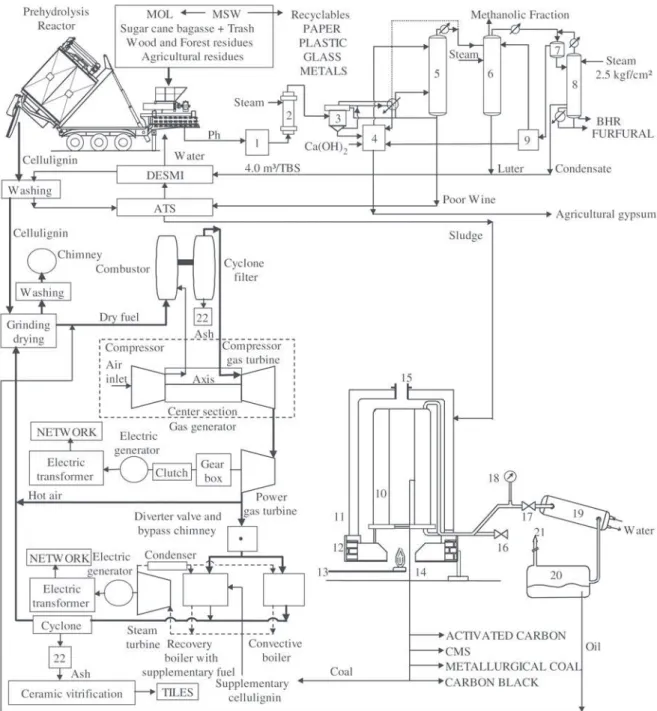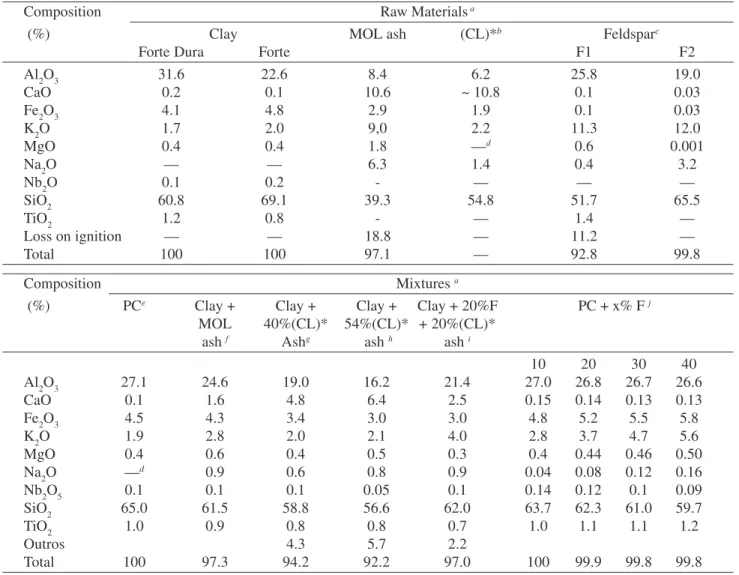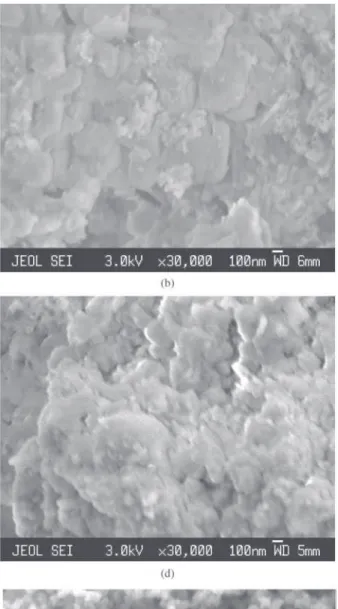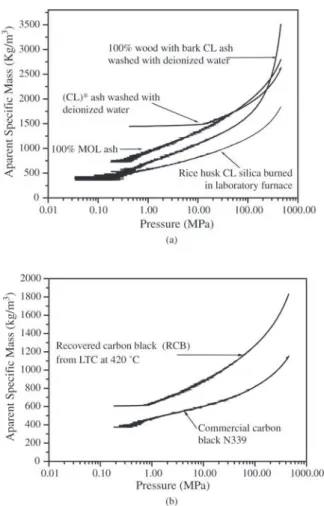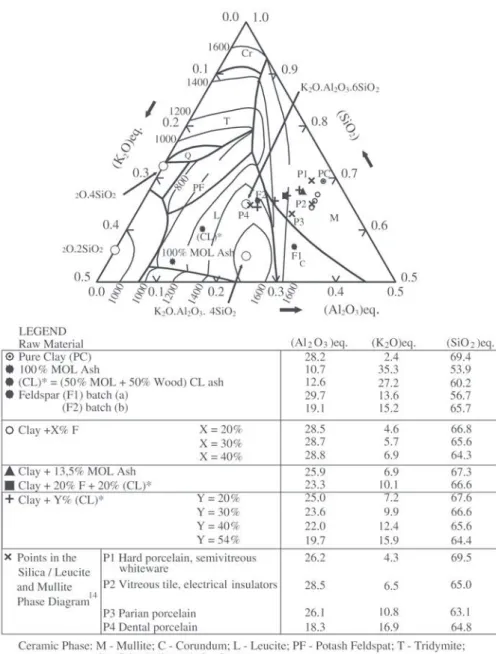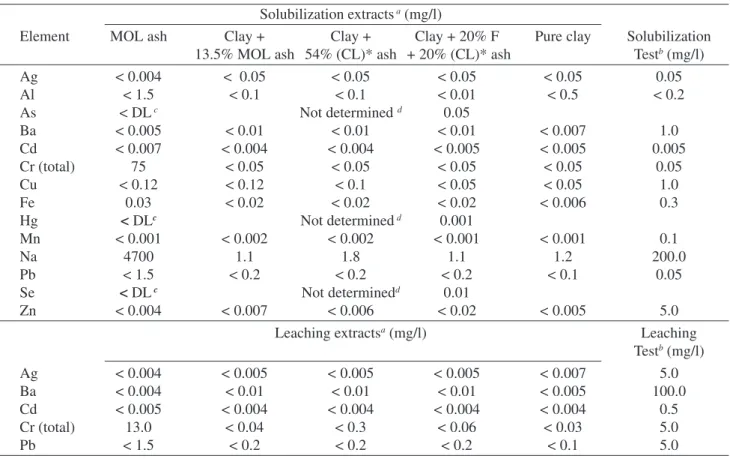*e-mail: pinatti@demar.faenquil.br
Trabalho apresentado no 1º Congresso da Sociedade Brasileira em Materiais, Rio de Janeiro, Julho de 2002.
Large Scale Low Cost Production of Submicrometric Powder
Through Biomass Refinery
Daltro Garcia Pinattia, Rosa Ana Contea, Mônica Castoldi Borlinia,
Benedito Celso dos Santosa, Marco Aurélio Marcondesa, Isaías de Oliveiraa,
Renata Garcia Oliveira Montanhaa, Álvaro Guedes Soaresb, Érica Leonor Romãob,
João Carlos Ferreirab , Maria Luiza Gonçalves Pereiraa
a
Department of Materials Engineering, FAENQUIL, C.P. 116, 12600-000 Lorena - SP, Brazil
b
R.M. Refractory Materials Ltda., C.P. 104, 12600-000 Lorena - SP, Brazil
Received: November 20, 2002; Revised: May 05, 2003
Biomass Refinery (BR) is a null pollution thermochemical sequential cracking of any biomass and some petrochemical products, which generates chemicals, liquid or solid fuels and inorganic submicrometric/nanometric powders (SM/NM) such as ashes, silica, and carbon black. The process-ing route, powder characterisation and addition of some ashes to red clay resultprocess-ing a grès-type ceramics will be presented. Rupture strengths of the vitrified ceramics were respectively 36 MPa for pure clay, 44 MPa for clay + 13.5% MOL ash (organic matter of municipal solid waste), 50 MPa for clay + 20% F+20% CL* ash (50% MOL + 50% wood) and 42 MPa for clay + 40% feldspar (used for comparison). The reason why the BR-ashes are better than feldspar is due to their submicrometric and partially nanometric nature. The impact of BR-ash technology can be evaluated by its national potential production of 2 × 106 ton/year only from municipal solid waste
(MSW) compared to 350,000 ton/year of national consumption. The first BR is under installation in Lorena - SP, Brazil.
Keywords: biomass refinery, submicrometric ash, vitrified ceramic, low temperature conversion
the future3; (2) BEM technologies process any kind of
biomass (wood and its residues, sugarcane bagasse and trash, agricultural residues, grass, organic matter of municipal solid waste – MOL, organic sludge and petrochemical polymer residues such as tires and plastics); (3) the six basic tech-nologies are a sequential cleaner of any potentially toxic elements (Ni, Cr, Cu, Cd, Zn, Pb, Hg, As, Se and Sb) and alkaline and alkaline-earth elements (K, Na, Ca, Mg) present in the raw materials. They generate clean products along the horizontal axis and concentrate the impurities in the vertical axis into a final submicrometric, partially nanometric powder (SM/NM), which is finally stabilised in vitrified
ceramic (grès-type or porcelain materials with 50 MPa of
flexural strength and 0.2% of water absorption). The hori-zontal axis (economical) and the vertical axis (ecological) represent the eco-eco concept. As water is completely recy-cled and CCTE produces clean gases the BR is an industri-alisation process with null pollution because no solid,
1. Introduction
A new concept of Biomass Refinery (BR) was devel-oped through a matrix ordination of basic technologies in the vertical axis (mechanical, thermochemical, biological, thermoenergetic and materials) and new materials and prod-uct technologies in the horizontal axis (Fig. 1). The main points of the BR are: (1) the hard core of BR, the so-called
BEM Programme (Biomass – Energy – Materials)1, is
com-posed of six basic technologies: prehydrolysis; furfural re-actor and its distillery; affluent treatment station used in closed cycle without any discharge to the environment; low
temperature conversion (LTC)2; combined cycle
Figure 1. Biomass Refinery basic technogies.
liquid or toxic gaseous emissions are discharged into the
environment. In the future CO2 released from the CCTE
will be collected into carbon molecular sieves (CMS)4 and
commercialised; (4) the main large-scale economical
prod-ucts that compete with other sources of materials and en-ergy are furfural (FF) and its derivatives including the eco-logical and most clean P-series fuel (50% ethanol, 30% > C5
(CL), oil (diesel, fatty and limonene-oil type), charcoal (fuel, metallurgical, activated and CMS), electric energy and the SM/NM powders. There are a large number of other prod-ucts that will be made competitive in a near future.
The first BR will be installed in Lorena - SP, Brazil. It will process 300 ton of dry biomass (TDB)/day of MSW from seven cities around Lorena, rice husks, wood residues, tires and organic sludge (domestic and industrial).
1.1 Basic Technologies and Products
The first basic technology to be considered is the di-luted acidic prehydrolysis of the biomass. The prehydrolysis reactor (Fig. 1) is made of steel lined with titanium and
operates at 0.8 MPa, 180 °C and 1.5% H2SO4 6. In the
proc-ess the hemicellulose of the biomass is hydrolysed to a sugar solution (mainly xylose), called prehydrolysate, that is the raw material for the FF plant. The solid product of the prehydrolysis is the cellulignin (CL), a fuel free of K+Na and with porosity at the macromolecular level (Fig. 2 - Ta-ble 1). The CL burns by its internal porosity without shrink-age of the particle diameter (φ < 200 µm) avoiding sintering
and resulting in a SM/NM particle7. The conventional
burn-ing occurs at the external particle surface with shrinkage and the high K+Na contents always cause sintering of the particle. Some prehydrolysis reactors are stationary for MOL processing and some move to the production sites for wood and agricultural residues processing, avoiding the high trans-portation cost of raw material.
The second technology is the furfural production8,9. It
consists of the dehydration of the prehydrolysate and distil-lations columns (Fig. 1). Besides the fact that furfural con-tributes to 25% of BR revenue it generates distilled water that, after demineralisation in a cationic resin column, is used for cellulignin washing aiming to lower the Na+K con-tents into the parts per million level.
Next technology is the affluent/water treatment station (ATS/WTS) that consists of the neutraliser, decanter, cavi-tated air flotation with belt sludge press and demineralisa-tion plant composed of sand/carbon filters and cademineralisa-tionic col-umn. This unit cleans the K + Na + Ca from the water to be recycled and resists organic contaminants. Anionic column does not resist organic contaminants and coincidentally it
is not necessary in the BF. Water recycling without disposi-tion to the environment avoids the need of biological treat-ments. The water comes from the biomass and leaves the refinery as steam in the CL dryer. The sludge goes to the low temperature conversion.
The low temperature conversion (LTC) reactor10 (Fig. 1)
has an annular furnace and a condensation unit. It is a her-metic catalytic process operating at 400 °C and produces distilled oil and coal. The LTC processes organic sludge, tires, and plastics. When the feeding material is clean the coal is used for domestic or siderurgical/metallurgical ap-plications and when contaminated it is burned in a control-led way in the thermoelectric boiler. There is no sintering of the ash in the LTC process.
The main equipments of the combined cycle thermo-electric plant – CCTE - (Fig. 1) are the cellulignin dryer, external combustor, cyclone filter, gas turbine/generator set and recovery boiler/steam turbine. The recovery boiler is divided into two units: the first uses contaminated coal as a supplementary fuel and the second unit is just a convective boiler. The combustion in the recovery boiler occurs at less than 800 °C; this avoids sintering of the ash and produces a SM/NM powder. All the ashes produced by conventional processes have high K+Na contents and they burn at tem-peratures higher than 800 °C, which promotes the sintering of the particles in crystalline forms with size particle above the micrometric range.
The revenue of BR distributes into 25% from recycla-ble materials, 25% from furfural, 45% from electric energy and 5% from SM/NM ash.
2. Experimental procedure
The red clay used in the work is from the Lorena City
and geologically belongs to the Taubaté Basin.
Its main phases are: quartz (SiO2-hexagonal);
kaolinite (Al2(Si2O5)(OH)4 - triclinic); muscovite
(KAl2(Si3Al)O10(OH)2 - monoclinic); and hematite (Fe2O3
-hexagonal). Muscovite (KAl2(Si3Al)O10(OH)2) and illite
(Kx(AlMg)4(SiAl)8O20(OH)4.nH2O) are different species,
both dioctaedric of the mica group with a 2:1 layer struc-ture. The qualitative phase identification in the clay, ashes
Table 1. Inorganic constituent concentrations of the Eucalyptus grandis wood and cellulignin produced from the wood (mg/g).
Fuel Ca K Na Mg P Al Si Mn Fe Zn S
Eucalyptus grandisa 510 630 100 260 120 240 140 25 40 10 180
Washed Cellulignin - PWb,c 55 40 45 20 < 15 130 160 2 15 10 80
Non Washed Cellulignin - DW a,d 120 35 55 30 < 15 220 120 1 15 8 200
Washed Cellulignin - DW a,d < 53 < 5 < 1 < 60 < 2 < 40 < 120 < 2 < 7 < 4 < 80
a Quantitative analysis by inductively coupled plasma optical emission spectrometry; b Prehydrolysis processed with potable water;
and ceramic materials was performed by X-ray diffraction. This technique was also applied to identify the transition from the crystalline to the amorphous (glass) state in the
ashes as a function of the sintering temperature11.
Presently the powders produced by the Biomass Refin-ery are: (1) ash of the organic matter of the municipal solid waste, obtained by the direct burning of the MOL at 700 °C. It is denominated 100% MOL ash; (2) ash of the burning of the cellulignin obtained by the prehydrolysis of a 100% wood, with and without bark (denominated 100% wood CL ash),
processed with potable and deionised water; (3) ash of the burning of the cellulignin obtained by the prehydrolysis of 50% MOL /50% wood, processed with potable and deionised water (denominated by (CL)* ash); (4) ash of the rice husk (silica), and (5) recovered carbon black obtained by the LTC of tires.
The microstructures of ceramic materials were charac-terised by scanning electron microscopy (SEM), using the LEO 1450 VP at DEMAR. Due to the SM/NM particle size nature of the ashes a high-resolution scanning electron
croscope was also used (SEM – FEG Jeol JSM-6330F) at the LME/LNLS, Campinas - SP, Brazil.
The pressing behaviour of the particles was observed through the compaction curves of the powders. A single action piston pressing was used .
The preparation of the ceramic mixtures followed a typi-cal procedure: the clay was disaggregated in a ball mill and classified in a 130 µm (100 mesh) sieve. The ashes were also desagglomerated in ball mills and classified in a 75 µm (200 mesh) sieve. Feldspar was used as received. Clay, ash and feldspar were mixed in a ball mill for one hour, wetted at 8% humidity, passed through a 425 µm (35 mesh) sieve, compacted at 18 MPa and dried at 110 °C for 24 h. Samples
of σmax = 54 MPa were obtained indicating that the ceramic
mixture preparation was adequate. The samples have
di-mensions of 114 mm in length, 25.4 mm in width and 6 mm in thickness. All samples were sintered at 1200 °C; pure
clay was also sintered at 1150 °C 12.
Weibull distribution (23 specimens) was applied to the rupture strength values (3-point flexural test) to investigate the mechanical behaviour of the ceramic materials.
Chemical analyses of the main constituents of the raw and ceramic materials were made by inductively coupled plasma optical emission spectrometry (ICP-OES) (Table 2). Solubilization and leaching tests (Brazilian Standards Se-ries 10000) were applied to the 100% MOL ash, (CL)* ash and to the ceramic materials obtained with the ash addi-tions in order to verify the mobility of pollutant metals. The potentially toxic metals (Ag, Al, Ba, Cd, Cr, Cu, Fe, Mn, Na, Pb and Zn) determination in the solubilization and
leach-Table 2. Chemical composition of the raw materials and ceramic mixtures.
Composition Raw Materials a
(%) Clay MOL ash (CL)*b Feldsparc
Forte Dura Forte F1 F2
Al2O3 31.6 22.6 8.4 6.2 25.8 19.0
CaO 0.2 0.1 10.6 ~ 10.8 0.1 0.03
Fe2O3 4.1 4.8 2.9 1.9 0.1 0.03
K2O 1.7 2.0 9,0 2.2 11.3 12.0
MgO 0.4 0.4 1.8 —d 0.6 0.001
Na2O — — 6.3 1.4 0.4 3.2
Nb2O 0.1 0.2 - — — —
SiO2 60.8 69.1 39.3 54.8 51.7 65.5
TiO2 1.2 0.8 - — 1.4 —
Loss on ignition — — 18.8 — 11.2 —
Total 100 100 97.1 — 92.8 99.8
Composition Mixtures a
(%) PCe Clay + Clay + Clay + Clay + 20%F PC + x% F j
MOL 40%(CL)* 54%(CL)* + 20%(CL)*
ash f Ashg ash h ash i
10 20 30 40
Al2O3 27.1 24.6 19.0 16.2 21.4 27.0 26.8 26.7 26.6
CaO 0.1 1.6 4.8 6.4 2.5 0.15 0.14 0.13 0.13
Fe2O3 4.5 4.3 3.4 3.0 3.0 4.8 5.2 5.5 5.8
K2O 1.9 2.8 2.0 2.1 4.0 2.8 3.7 4.7 5.6
MgO 0.4 0.6 0.4 0.5 0.3 0.4 0.44 0.46 0.50
Na2O —d 0.9 0.6 0.8 0.9 0.04 0.08 0.12 0.16
Nb2O5 0.1 0.1 0.1 0.05 0.1 0.14 0.12 0.1 0.09
SiO2 65.0 61.5 58.8 56.6 62.0 63.7 62.3 61.0 59.7
TiO2 1.0 0.9 0.8 0.8 0.7 1.0 1.1 1.1 1.2
Outros 4.3 5.7 2.2
Total 100 97.3 94.2 92.2 97.0 100 99.9 99.8 99.8
aAnalysis by inductively coupled plasma optical emission spectrometry (ICP-OES); bSemi-quantitative analysis; cSupplier data; d— Not
determined; eSintered clay without any addition; fClay + 13.5% MOLash; gClay + 40% (CL)* ash; hClay + 54 % (CL)* ash; iClay +
ing extracts of some ashes and ceramic materials prepared with ash additions was also carried out by ICP-OES.
3. Results and discussion
The microstructures of the powders (Figs. 3a-3f) presented the following characteristics: 100% MOL ash shows elemen-tary particle sizes less than 100 nm and agglomerates greater than 2 µm (Fig. 3a). Particle distribution measurements (sedi-mentation technique with laser Horiba model CAPA-700) shows agglomerate diameters of (6.27 ± 9.22) µm. Ash of (CL)* washed with deionised water shows a fraction of the particles with 1 µm in size (due to the clay contamination in the MOL), and a fraction with particles of 100 nm in size (due to the biomass ash) (Fig. 3b). Particle distribution measurements show agglomerate diameter size of (4.80 ± 7.94) µm. Ash of 100% wood washed with deionised water shows elementary particle sizes less than 100 nm and agglomerates greater than 2 µm (Fig. 3c). Silica of rice husk cellulignin washed with potable water and burned at 700 °C shows elementary particle size of 100 nm and agglomer-ates greater than 2 µm (Fig. 3d). Recovered carbon black from low temperature conversion of tires at 420 °C, heated at 800 °C for 30 min and desagglomerated by attrition mill-ing shows elementary particle size of 60 nm (Fig. 3e) simi-lar to the commercial carbon black CCB N339 (Fig. 3f). The specification of particle size of the commercial carbon black is 30 nm. SEM measurements of the commercial pow-der indicate that the elementary particle size is higher than the actual size, that is, the resolution of the scanning micro-scope has reached its limit.
The compaction curves (Figs. 4a-4b) showed the follow-ing characteristics: (1) the presence of the three stages of compaction (flux and rearrangement, deformation and densification of the agglomerates); (2) very low apparent spe-cific mass (ASM) in the first stage; (3) in the transition from the second to the third stage (pressures ≈ 200 MPa) the ASM
has typical values (> 1800 kg/m3) for the ashes but low
val-ues for the silica and RCB (< 1200 kg/m3). CCB N 339 has
lower value than RCB, indicating the possibility of improve-ments in the process. The low values of ASM are corrobo-rated by the sample electrical charging in the SEM measure-ments, even with a gold coating of 20 nm in thickness, which can be attributed to a polarisation of those powders.
Cellulignin is a catalytic fuel to be burned in gas tur-bines. The definition of the maximum working temperature of the turbine determines the power to be achieved. On the other hand, working temperature must be such that ash de-posits in the vanes and blades are avoided. The use of nor-malised integrated intensity of X-ray diffraction peaks as a function of the sintering temperature of the ashes allows the definition of the transition temperature from the crys-talline to the glassy phase. The data of Fig. 5 show that all
samples bump up at the following temperatures: 100% MOL - 650 °C; (CL)* ash washed with deionised water - 750 °C; ash of 100% wood CL with bark washed with deionised water - 800 °C. The technique has proved to be very effec-tive for the definition of the maximum working tempera-ture of a gas turbine burning cellulignin in an external com-bustor without generating ash deposits in the vanes and blades. It is possible to work at 750 °C when the MOL is present (5.5 MW power in the GE/LM 1500 gas turbine) and at 788 °C with pure wood cellulignin (9.5 MW in the same turbine)13,14.
The constituents of the ash in the biomass can be
classi-fied in four groups15: refractory materials (Si, Ti, Al),
alka-line and alkaalka-line-earth materials (K, Na, Ca, Mg), non-me-tallic materials (Cl, S, P) and iron (Fe). Thermogravimetric (TG) and differential thermal analysis (DTA) were carried out for three types of ashes (Fig. 6a-6b). The results do not correlate with the composition of the ash deposits (sintered or melted) because their constituents occur in various forms of dissolved salts, cations attached to carboxylic and other functional groups, complex ions, chemisorbed materials, oxides, silicates and sulphides. Based on the TG data the final mass loss of the 100% MOL ash is 30% and the others are around 10%. The difference is due to the losses in the prehydrolysis process. Although DTA data are quite con-fusing it is possible to identify some peaks: liberation of liquid and adsorbed water at 85 °C, liberation of cation coordinated water at ≈ 300 °C (end of positive slop in the DTA curve), liberation of constitutional water at ≈ 500 °C,
eutectic transformation present in the SiO2-K2O phase
dia-gram at ≈ 760 °C; melting or decomposition of CaCO3
(1339 °C), CaSO4 (750 - 950 °C in the presence of silicates),
MgSO4 (1124 °C - decomposition), melting of FeS2
(1171 °C) explaining the decrease of all curves between 950 and 1150 °C. The exothermic peak around 1150 °C is not well understood but it indicates that some carbon is being burned. In this paper DTA data above 1200 °C will not be analysed. Comparing the data of the Fig. 5 and Fig. 6 it is clear that the integrated intensity of the X-ray diffraction peaks technique developed in this work correlates better with the temperature of the ash deposits in the boiler and gas
turbine than TG/DTA data, as stated in the literature15.
3.1 Mechanical behaviour of the vitrified ceramics
The 100% MOL ash, the (CL)* ash and feldspar were added to a kaolinitic/muscovite red clay available in the
Figure 6. a) Thermo-gravimetric analysis of some ashes; b) Dif-ferential thermal analysis of some ashes.
Figure 5. Normalised integrated intensity of X-ray diffraction peaks as a function of the sintering temperature of some ashes. Figure 4. Compaction curves for some powders produced by the Biomass Refinery: a) Compaction curves of ashes and silica; b) Compaction curves of recovered and commercial N339 carbon black.
A concept of an “equivalent composition” is introduced for the vitrified ceramics. It means to group the inorganic constituents according to their behaviour in the ceramic
phase diagram. The refractory constituents (Al2O3 and TiO2)
are grouped under the designation of Σ (Al2O3)eq.Iron
ox-ide is grouped with silica due to its intermediate melting point, between the refractories and fluxes, giving the
Σ (SiO2)eq. The fluxes Na2O, K2O, CaO and MgO are put
together under the designation of Σ (K2O)eq. Figure 7 shows
the “equivalent composition” phase diagram where some ceramics and some points of the silica/leucite/mullite phase
diagram are indicated (P1 to P4)16. The addition of the
feld-spar (F1 batch - z) in the pure clay (PC - ~) situates the
materials ({) on the PC-F1 with constant Σ (Al2O3)eq.A
line (+) in a direction of lower Σ (Al2O3)eq content and higher
Σ (SiO2)eq andΣ (K2O)eq contents. The materials clay + 13.5%
MOL ash (S), clay + 20% F + 20% (CL)* ash () and
clay + Y% (CL)* ash (+) (Y= 20, 30, 40, and 54%) are along the PC-(CL)* line. Materials with proximate compo-sitions have completely different properties. This fact may indicate that the nanometric fraction of the ash has a sig-nificant effect on the microstructures and properties of the ceramics.
Figure 8 shows the rupture stress as a function of
Σ (K2O)eq where it is indicated the Weibull distribution
pa-rameters σo and m, the water absorption and the linear
re-traction values for some vitrified ceramics prepared accord-ing to the compositions given in Table 2.
At the present stage of development the following points can be mentioned:
(1) The addition of feldspar in the PC (σo = 36 MPa) has
firstly decreased the rupture stress to 28 MPa and then has
increased it to a 40 MPa level for 40% F addition. The
addi-tion of the (CL)* ash has decreased σo to the 30 MPa range
and showed a bimodal Weibull distribution for (CL)* ash
> 40% (Σ (K2O)eq > 7.5%) probably due to a double region
of phases, similar to the double phase behaviour in Si3N4 17.
This agrees with the location of the clay + 40% (CL)* and clay + 54% (CL)* materials near the boundary of the mullite/ corundum/leucite phases, and may explain the not well un-derstood behaviour of the decreasing of the ceramic strength
with the addition of conventional ashes and residues18-20.
The addition of 13.5% MOL ash results in σo = 46 MPa,
water absorption = 1.2% and m = 14. Although very attrac-tive as an addiattrac-tive MOL ash is an expensive material be-cause it comes from the direct burning of the MOL without generating any furfural or electric energy. Industrially the ash from the controlled burning of the LTC coal obtained from the sludge will replace the MOL ash. This ash
con-tains most of the Na2O+K2O+CaO digested in the
prehydrolysis plant. The materials prepared with 20%(CL)*
ash + 20%F resulted in a porcelain ceramic (σo = 51 MPa,
m = 14, water absorption = 0.2%, Σ(K2O)eq = 7.6%). The
explanation for such good results may come from two rea-sons: (a) in general, clays and feldspar consist of mineral particles with diameters above micrometric size. The vitri-fication homogeneity at the microscopic level depends on the liquid sintering mechanism hindered by the very high viscosity and (b) (CL)* and MOL ashes are SM/NM parti-cles known to have lower melting point than micrometric particles, thus originating a fraction of liquid with lower viscosity and higher mobility. The overall result is a better homo-geneisation.
(2) Application of the Griffith criteria of fracture
me-chanics to the red clay states that K1c = 1.12 σ (πc)1/2 where
K1c = 0.59 MPa.m1/221. Based on the results of the Weibull
distribution of the rupture stress, the critical fault length was calculated for four ceramics: clay + 13.5% MOL ash (84 µm), clay + 30% F (196 µm), clay + 54% (CL)* ash (283 µm), and clay + 20% F + 20% (CL)*ash (68 µm). Figs. 9a-9f show the scanning electron micrographies of the fracture surface on the flexural edge of some ceramics
sintered at 1200 °C and the bimodal Weibull distribution of the clay + 54% (CL)* ash. All ceramics showed a monomodal Weibull distribution except the material pre-pared with the addition of more than 40% (CL)* ash. This result is in agreement to the data of Fig. 7 where those
com-positions situate in the phase boundaries of the mullite/co-rundum/leucite region. The microstructure of the pure clay (Fig. 9a) shows an incomplete sinterization in the bulk and some crystallisation in the edge. Clay + 20%F + 20% (CL)* ash microstructure (Fig. 9b) shows a high degree of sintering,
and crystallisation in the bulk and in the edge. X-ray dif-fraction measurements on this sample showed the follow-ing phases: quartz, cristobalite, mullite, corundum, and labradorite (NaO0.4CaO0.6)Al1.6Si2.4O8). The material clay + 30% F (not shown in the figure) has an incomplete sintering, and crystallisation only in the edge. Figure 9c shows the microstructure of the clay + 54% (CL)* ash for a sample at the lower mode of the Weibull distribution; Fig. 9d refers to the same material at the higher mode. The specimen at the lower mode showed a double region of phases, similar to the
double phases in Si3N4, a ceramic material that presents a
bimodal distribution17,22. The double region of phases in this
work may be due to the composition close to the phase boundaries of the mullite/corundum/leucite region. Figure 9e shows the bimodal Weibull distribution of clay + 54%(CL)* ash and Fig. 9f shows the immiscibility of glass in glass in that material. High-tech methodologies open opportunities
to understand high quality red ceramics23, particularly the
addition of ashes that has been a “black box”.
The utilisation of agricultural, industrial or municipal
Table 3. Potentially toxic metals in the solubilized and leached extracts of MOL ash and some vitrified ceramics.
Solubilization extracts a (mg/l)
Element MOL ash Clay + Clay + Clay + 20% F Pure clay Solubilization
13.5% MOL ash 54% (CL)* ash + 20% (CL)* ash Testb (mg/l)
Ag < 0.004 < 0.05 < 0.05 < 0.05 < 0.05 0.05
Al < 1.5 < 0.1 < 0.1 < 0.01 < 0.5 < 0.2
As < DL c Not determined d 0.05
Ba < 0.005 < 0.01 < 0.01 < 0.01 < 0.007 1.0
Cd < 0.007 < 0.004 < 0.004 < 0.005 < 0.005 0.005
Cr (total) 75 < 0.05 < 0.05 < 0.05 < 0.05 0.05
Cu < 0.12 < 0.12 < 0.1 < 0.05 < 0.05 1.0
Fe 0.03 < 0.02 < 0.02 < 0.02 < 0.006 0.3
Hg < DLc Not determined d 0.001
Mn < 0.001 < 0.002 < 0.002 < 0.001 < 0.001 0.1
Na 4700 1.1 1.8 1.1 1.2 200.0
Pb < 1.5 < 0.2 < 0.2 < 0.2 < 0.1 0.05
Se < DL c Not determinedd 0.01
Zn < 0.004 < 0.007 < 0.006 < 0.02 < 0.005 5.0
Leaching extractsa (mg/l) Leaching
Testb (mg/l)
Ag < 0.004 < 0.005 < 0.005 < 0.005 < 0.007 5.0
Ba < 0.004 < 0.01 < 0.01 < 0.01 < 0.005 100.0
Cd < 0.005 < 0.004 < 0.004 < 0.004 < 0.004 0.5
Cr (total) 13.0 < 0.04 < 0.3 < 0.06 < 0.03 5.0
Pb < 1.5 < 0.2 < 0.2 < 0.2 < 0.1 5.0
aDetermination by inductively coupled plasma optical emission spectrometry (ICP-OES); bMaximum allowed limits by NBR 10004; cDetermination by an independent laboratory Ambiental Laboratórios e Equipamentos Ltda; dElements not determined because their contents in the raw materials were already lower than the standard specifications.
solid waste residues as additive to prepare any kind of mate-rials has to fulfil the requirements of environmental control. Solubilization and leaching tests were performed in the MOL ash and some vitrified ceramics following the Brazilian
stand-ard NBR 10006 and NBR 10005, respectively24,25. Results of
the determination of potentially toxic metals in the extracts are shown in Table 3. The MOL ash does not meet the
speci-fications of NBR 10004 standard26. All ceramics fulfil the
standard requirements for most elements. This means that the solid residues generated in the BR can be aggregated to the ceramic materials, accomplishing the null pollution processing cycle. Some elements (Al, Cd and Pb), present in very low concentrations, presented limits of detection above their concentration requirements due to the low sensitivity of the emission lines used for the determination by ICP-OES. For these elements analysis by graphite furnace atomic
ab-sorption spectrometry will be carried out27.
no economical benefits is not enough. The present work showed that it is also possible to obtain high-quality ceram-ics with partial addition of low cost SM/NM ash.
Besides the high quality of the ceramics produced with the addition of a mixture of ash/feldspar, the impact of the Biomass Refinery in the ceramic industry can be evaluated by the following numbers. The national consumption of feldspar is of 350,000 ton/year and the world production is of the order of 10 million ton/year (Italy - 2,700,000 ton/year, Japan - 1,200,000 ton/year, USA - 900,000 ton/year, France
- 600,000 ton/year and Spain - 500,000 ton/year)28. National
MSW production is about 33 × 106 ton/year with an ash
content of 6% 29. This generates 2 × 106 ton/year of ash,
which represent 5.7 times the national feldspar consump-tion. The processing of only 17.5% of MSW in the Biomass Refinery is enough to double the feldspar supply. Other biomasses can also be considered: wood residues
(85 × 106 ton/year, 1.2% ash, 1 × 106 ton/year of ash) and
sugarcane bagasse and trash (78 × 106 ton/year, 2.5% ash,
2.0 × 106 ton/year of ash)1. Generally, the ash of these
biomasses returns to the forest and sugar fields for fertilisa-tion, causing some degree of contamination of the under-ground water.
4. Conclusions
The basic technologies prehydrolysis, furfural produc-tion, affluent treatment staproduc-tion, low temperature conversion, combined cycle thermoelectric and ceramic vitrification form the necessary and sufficient technological package for the establishment of an economic and ecological Biomass Refinery. Natural (MOL, agricultural residue, wood, grass) and petroleum polymeric materials (tires, plastics) are proc-essed by the BR. Null pollution concept is achieved with no disposition of solid, liquid or polluted gaseous emissions.
In the future CO2 will also be collected and
commercial-ised. The ashes from the BR are not sintered because all process occur in low temperatures. They are SM/NM parti-cles, opening new opportunities for engineered materials (feelers, ceramics and new materials). The BR ashes can
partially replace feldspar generating grès-type and
porce-lain ceramics. The amount of ash can reach millions of ton/year with residual costs. The BR yields low cost cellulignin fuel for sintering industries and allows local pro-duction of high-quality ceramics with repro-duction of freight cost.
Acknowledgements
The authors wish to thank the use of the SEM – FEG Jeol JSM-6330F electron microscope at the LME/LNLS, Campinas - SP, Brazil. The authors I. de Oliveira and Mônica C. Borlini wish to thank Fapesp for their master fellowship, and M.L.G. Pereira wishes to thank Fapesp for her
doctor-ate fellowship. The author Marco A. Marcondes wishes to thank CAPES for the master fellowship.
References
1. Pinatti, D.G.; Couto L.; Soares, A.G.; Vieira, C.C.; Conte, R.A. Proceedings of the 3rd Meeting of the International Energy Agency- Bioenergy, Task 17- Short-Rotation Crops for Bioenergy, Auburn, USA, p.17, september/ 1999.
2. Bayer, E. Process for Producing Solid, Liquid and
Gase-ous Fuel from Organic Starting Material US Patent number 5.114.541, may/1992.
3. Biobased Industrial Products: Priorities, Research and Commercialization, National Academy Press, Washing-ton DC, USA, 1999.
4. Soares, A.G. Absorção de Gases em Carvão Ativado de
Celulignina, Tese de Doutorado, IFGW, UNICAMP, Campinas, SP, 174 p. , 2001.
5. Pure Energy Corporation:10 CFR Part 490: Alternative
Fuel Transportation Program; P-series Fuels, Final Rule DOE: Office of Energy Efficiency and Renewable En-ergy, Federal Register, v. 64, n.94, p. 26822, may/1999
6. Romão, E.L. Pré-hidrólise da Matéria Orgânica do Lixo
Municipal, Dissertação de Mestrado, DEMAR,
FAENQUIL, Lorena, SP, 147 p., 2000.
7. Vieira, C.A. Fundamentos da Combustão da Celulignina
e suas Aplicações como Combustível de Caldeiras,
Turbinas e MHD, Tese de Doutorado, IFGW, UNICAMP, Campinas, SP, 205 p., 2000.
8. Ferreira, J.C. Otimização dos Reatores de Furfural
Fabricados com Metais Refratários, Dissertação de Mestrado, DEMAR, FAENQUIL, Lorena, SP, 86 p., 2002.
9. Montanha, R.G.O. Controle Químico da Produção de
Furfural pelo Processo de Duas Etapas, Dissertação de Mestrado, DEMAR, FAENQUIL, Lorena, SP, 2002. 10. Oliveira, I. Reciclagem de Pneus através de Conversão
em Baixa Temperatura – CBT, Exame de Qualificação de Mestrado, DEMAR, FAENQUIL, Lorena, SP, 2002.
11. Marcondes, M.A. Estudo da Temperatura de Início da
Formação de Fase Vítrea nas Cinzas de Biomassa, e Interações dessas com Tubinas a Gás, Dissertação de Mestrado, DEMAR, FAENQUIL, Lorena, SP, 78 p, 2002.
12. Santos, B.C. Adição de Cinzas da Celulignina em Placas Cerâmicas, Dissertação de Mestrado, DEMAR, FAENQUIL, Lorena, SP, 2002.
13. Joseph, R.W. System for Burning Biomass to Produce
Hot Gas, US Patent number 5.720.165, february/1998. 14. Bioten Process-Renewable Electric Energy, Knoxville,
TN, USA, 13 p.,1999.
15. Miles, T.R.; Miles Jr, T.R.; Baxter, L.L.; Bryers, R.W.;
Deposits Found in Biomass Power Plants- A Prelimi-nary Investigation of Their Extent and Nature, National Renewable Energy Laboratory, CO, USA, 120 p., april/ 1995.
16. Kingery, W.D.; Bowen, H..K.; Uhlmann, D.R.
Intro-duction to Ceramics, Wiley & Sons, New York, USA, p. 533, 1976.
17. Richerson, D.W. Modern Ceramic Engineering, Marcel
Dekker, New York, USA, p. 669, 1992.
18. Basegio, T.M.; Berutti, F.A.; Bergmann, C.P. Anais do
45o CBC, Florianópolis, SC, CD-ROM 0401501, junho/
2001.
19. Basegio T.M. ; Berutti, F.A.; Bergmann, C.P. Anais do
14o CBCIMAT, São Pedro, SP, CD-ROM 12801,
dezembro/2000.
20. Oliveira, H.A.; Cunha, E.S.; Gibo, R.M.; Bressiani, J.C.
Anais do 43o CBC, Florianópolis, SC, CR-ROM 02001,
julho/1999.
21. Vieira C.M.F. Vitrificação de Argilas Vermelhas de Campos dos Goytacazes, RJ, Dissertação de Mestrado, CCT-LAMAV, UENF, Campos dos Goytacazes, RJ, 1997. 22. Absi, J.; Glaudus, J.C. Numerical separation of
bi-mo-dal strength distribution, J. European Ceramic Society, 22, 2002, p 593-601.
23 Xavier, C. Anais do 14o CBCIMAT, São Pedro, SP,
CD-ROM 050001, dezembro/2000.
24. NBR 10006 - Solubilização de Resíduos
Sólidos-Procedimentos, 2 p., setembro/1987.
25. NBR 10005 - Lixiviação de Resíduos
Sólidos-Procedimentos, 2 p., setembro/1987.
26. NBR 10004 – Resíduos Sólidos-Classificação, 48 p.,
setembro/1987.
27. Borlini, M.C. Estabilização de Metais Pesados nas
Cinzas e em Cerâmicas Vermelhas Preparadas com Adição de Cinzas do Lodo e da Celulignina do Processo de Pré-hidrólise da Matéria Orgânica do Lixo, Dissertação de Mestrado, DEMAR, FAENQUIL, Lorena, SP, 189 p., 2002.
28. Coelho, J.M.; Suslick, S.B.; Souza, M.C.A.F. Anais do
43o CBC, Florianópolis, SC, CD-ROM 07601, junho/
1999.
29. D’Almeida, M.L.O.; Vilhena, A. Lixo
Municipal-Manual de Gerenciamento Integrado, 2a edição,
